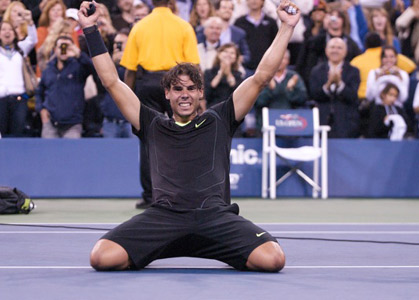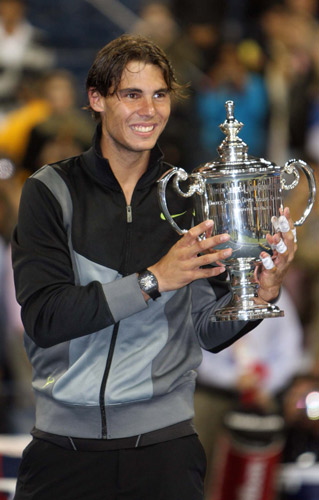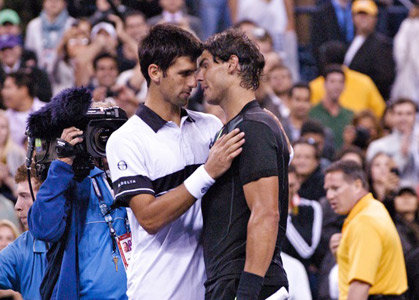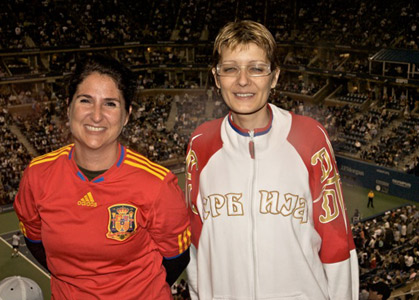EE9BC994-B9ED-4BB4-BF1A-11EEDA3AA2CC

By Richard Pagliaro
© Andy Kentla
© Michael O'Kane
(September 13, 2010) Hurling himself into the final ferocious forehands of the night like a fighter unleashing uppercuts with incisive intentions, Rafael Nadal took his shot at tennis history on the rise and completed his Grand Slam coronation in stirring style tonight.
Nadal captured his first career US Open championship to complete the career Grand Slam with a 6-4, 5-7, 6-4, 6-2 victory over Novak Djokovic in the Flushing Meadows final at Arthur Ashe Stadium.
The top-seeded Spaniard is now a master of all major surfaces; a champion for the ages.
"It's more than I dreamt," said Nadal, whose fingertips, still tinged with adhesive tape, tickled the shiny silver title trophy that eluded him for so long. "I know, for me, it's a dream have the career Grand Slam, but this is more (of a) dream (to) have the US Open. Is some moments unbelievable feeling because I worked a lot all my life, in all difficult moments to be here, but I never imagined have the four Grand Slams."
At the age of 24 years, 101 days, Nadal is just the seventh man in history to complete the career Grand Slam. Nadal is the first man since Rod Laver in 1969 to win Roland Garros, Wimbledon and the US Open in succession. He is the third youngest man to complete the career Grand Slam after Don Budge (22 years, 357 days) and Laver (24 years, 32 days).
On championship point, Nadal coaxed a final forehand error from Djokovic, watched Djokovic's shot sail wide, dropped his Babolat racquet and fell flat on his back behind the baseline while camera flashes flickered continuously like a force of fireflies descending on Flushing Meadows to light up the night. Then he rolled over on his stomach, his palms pressing down on the court as if embracing the largest Grand Slam stage in the world, a court that had pounded both his body and psyche in the past, with the heart-felt hug of man finding a long-lost friend.
This victory, one of the most memorable in a career filled with spectacular spikes, was special because it was rooted in loss. Nadal endured an 11-month title drought he snapped in April winning his sixth straight Monte Carlo on his beloved red clay. He had not won a hard-court title since the 2009 Indian Wells, but withstood a one-day rain out and a ran delay to eradicate that drought in the city that had long served as his personal road block to tennis immortallity.
"You know, there are moments when you are not playing that good, when you lose your confidence, you lose matches, and seems like you are not playing that good and you forgot to play tennis," Nadal said. "It's not like this, and it is not like this I improved a lot since 2009. I think I improved my tennis a little bit but is not a radical change, no? Sure, to win in here in the US Open I think is the more difficult tournament for me to play, more difficult conditions to adapt, to adjust my game on this court, for the balls, for the court, for everything, no?"
Throughout his career, the US Open was the one major title eluding him, but on this night, in this event, Nadal conquered the hard court once deemed to fast for game and brought more than 22,000 adoring fans along for the ride.

When it was over the appreciative Arthur Ashe Stadium crowd stood and gave both men a rousing ovation.
It's a testament to how fast things can change in tennis. A year ago, Nadal, bothered by a strained abnominal muscle, suffered one of the worst beatings in his Grand Slam career in a 6-2, 6-2, 6-2, mauling at the hands of Juan Martin del Potro. Two months later in London, Nadal did not even win a set in losses to Nikolay Davydenko, Robin Soderling and Djokovic. There was the emotional distress of his parents divorce that caused Nadal, who lives with his family in the Mallorca of his youth, into a malaise that lasted months.
"Last year I had a difficult year. Well, I had a great year because when you win a Grand Slam and three Masters 1000 you have a great year, but is true the second half of the year was very difficult for me, have some personal problems, home, and after, I have a lot of injuries, here the abdominal, before, the knees," Nadal said. "So, yeah, wasn't an easy year. But is, at the same time, for sure, is not good have these moments but live these moments but at the same time, yes, because after that, when you come back, you are ready to value how difficult is win titles and how difficult is be there all the time, no?"
Absorbing such severe thrashings in the latter stages of last season might have sent some players for an extended break or a consultation with a sport psychologist.
Not Nadal.
Gazing out at the media in his post-match press conference tonight you wonder if Nadal was thinking to himself "weren't these the same people writing I'd be done at 26?" as he explained how he's turned the last six months into his own personal coronation. While Nadal spoke his father Sebastian, showing sensitivity for the firing squad of photographers and cameramen in the back of the interview room ducking to avoid obstructing their shots as he snuck into the second to last row, sat and listened..
"Well, the life change sometimes, no? Ten months ago seems like I never gonna be another time the same," Nadal said in a subtle reference to past speculation of his career demise. "Now seems I gonna be one of the greatest, so I don't think that's not that bad in that moment and not that good in this moment. So always is in the middle, I think, no?"
It is the ninth career major championship for Nadal, who is the first Spanish man since Manuel Orantes in 1975 to win the US Open. He spent some of the early years of his career as the second-seeded shadow to 16-time Grand Slam king Roger Federer. But now Nadal, five years Federer's junior and owning a 14-7 career edge over the Swiss stylist in their head-to-head series, can stake a claim as one of the greatest players of all time. Should he he continue his winning pace, and there's no one on the horizon who appears capable of slowing Nadal's Roland Garros reign, can the muscular Mallorcan surpass Federer as the mythical Greatest Of All Time?
"Definitely," Djokovic said without hesitation tonight. "He has the capabilities already now to become the best player ever. I think he's playing the best tennis that I ever seen him play on hardcourts. He has improved his serve drastically. The speed, the accuracy, and of course his baseline is as good as ever. So he's a very complete player."
Contesting his second US Open final, Djokovic carried a 7-3 career hard-court record against Nadal, including three consecutive hard-court wins in their last three meetings, into the final. The 2007 US Open runner-up reinvented himself during this Flushing Meadows fornight, from an ultra-talented but slightly soft player, to a fierce competitor who poured every piece of himself into the semifinal and final.
The pivotal point of the match came with Nadal serving at 5-4 in the third set and Djokovic sniffing for a break at 15-30 that likely would have brought the boisterous house down at that point. Long and lean, Djokovic has an expansive reach that makes him arguably the best hard-court returner in tennis, but Nadal snuffed out the Serbian's hopes with three successive stinging serves that left Djokovic flailing at air.
"For me, in order to win against him tonight, I had to be on the top of my game. I was playing really well for most of the match, but then there were some moments in, let's say, third and fourth set where I dropped my focus a little bit," Djokovic conceded. "I dropped my level of game and just a little bit on service games. It went for me. He took it away, and he never gave me a chance to go back. I had this 15-30 chance in 5-4 third set, and then he served, I mean, three amazing serves. So I think that's one of the key factors today in his win except an amazing baseline game, of course, and great coverage of the court. The serve was fantastic the whole tournament."
Adopting a slight grip change and appearing to throw his toss out a bit more into the court, Nadal's serve was the keystroke to the entire tournament. He dropped serve only twice in 91 service games entering the final and surrendered serve three times against Djokovic, but delivered authoritative serves when it mattered most.
"So that was a very important moment, and at that moment I did something that I never did: three serves, one ace and two service winners," Nadal said. "So that's the big experience for me, and believe me, that's good."
Solidifying his status as the best big-match player in the sport, Nadal is 6-0 in his last six Grand Slam finals. The World No. 1 is 9-2 in Grand Slam finals and owns a 6-2 advantage in their major meetings. The talk around the water cooler, on the 'Net and in the sports bars (yes, people actually do talk tennis in sports bars in New York, at least during the US Open anyway) in the coming days will revolve around the Roger-Rafa issue. Now that Nadal has mastered every major is he closing in on surpassing Federer for the GOAT?
Don't ask Nadal. He tends to chuckle at repeated media efforts to elicit any trace of self-promotion in that race even calling the comparison "stupid" after the final.
"I think is talk about if I am better or worse than Roger is stupid, because the titles say he's much better than me, so that's the true at that moment. I think will be the true all my life," Nadal said. "But, sure, for me, always, always Roger was an example, especially because he improved his tennis I think during all his career, and that's a good thing that you can copy, no? So I try to copy this, and I know Roger and me are different, much different styles. Being better than Roger I don't think so is the right moment to talk about that, because I don't think that."
His performance demands consideration in that conversation.
Racing so far behind the baseline he could have almost tapped the blue back wall with his racquet, Nadal ripped running backhand passes that left Djokovic shaking his head in disbelief at times.

The match featured six rallies of 20 more strokes and those punishing exchanges took a toll on Djokovic, whose depleted legs, drained from the five-set fight with five-time champion Roger Federer in the semifinals, looked like licorice by the early stages of the fourth set.
A rhythm player who actually seems to grow stronger as the match goes longer, Nadal was seemingly swinging with even more force as he saw the finish line in the fourth set.
A titanic topspin forehand down the line gave Nadal a double break point in the third game of the fourth set. Djokovic retaliated with his own ripping forehand down the line to save the first break point, but that shot was effectively the Belgrade baseliner's last stand. A Djokovic forehand tripped on the tope of the tape and landed long as Nadal broke for 2-1.
Two games later, Nadal was at it again, pummeling punishing shots that hounded Djokovic like a pack of pit bulls unleashed on a trespasser. When Djokovic, who fought so hard for so long, flattened a forehand into the net, he hung his head falling into a 1-4 hole, wearing the weary resignation of a man well aware the dream was evaporating in the night air.
Djokovic was serving at 4-all, 30-all in the second set when the skies opened up and rain began pouring down. Tournament referee Brian Earley, clutching his ever-present walkie talkie came out quickly and acted decisively. "We're going in. Take them in," Earley told the security team, which escorted Nadal and Djokovic back into the locker room.
After a one hour, 57-minute rain delay, the players returned to the court at about 7:48 and Djokovic struck the serve that officially resumed play at 7:59.
Serving at 5-6, Nadal bumped a drop volley into net to fall to 30-all. Djokovic drilled a backhand down the line to draw an error and earn break point.
Reading the serve down the T, Djokovic moved right to cut off the angle and drove a forehand return down the middle that flirted with the front of the baseline. Forced to respond off his back foot, Nadal could only lift an off-balance forehand into the net as Djokovic broke to seze the second set.
Winding up for a windmill fist-pump, the veins bulging in Djokovic's neck were visible from courtside as he trotted to his court-side seat deadlocked at one set apiece.
Sprinting seven feet behind the baseline, back in the territory typically occupied by ball kids, Nadal somehow angled a backhand pass crosscourt to earn triple break point at 0-40 in the third game of the third set. Djokovic erased the first with an ace and saved the second when Nadal netted a backhand. On the third break point, Djokovic slice a serve wide, drew the short ball he desired, but lifted a crosscourt forehand wide as Nadal broke for 2-1. Nadal quickly consolidated for 3-1.
Cranking up the pressure like as if tightening a tennis vise, Nadal earned five break points in the seventh game of the fourth set. Serving under immense pressure, Djokovic played with more aggression on the break points and time after time denied Nadal a second break. Attacking net, Djokovic saved a fifth break point when Nadal mis-fired on a backhand pass. A gam that featured 16 points and spanned more than 11 minutes finally ended when Nadal knocked a backhand into net.
Djokovic dug out a hard-fought hold for 3-4, but his legs and lungs paid a steep price.
Serving for the set at 5-4, Nadal went toe-to-toe with Djokovic in a demanding rally that spanned more than 20 shots. It ended with Djokovic clocking a crosscourt forehand winner. Another fierce forehand down the line drew Djokovic to 15-30.
A determined Djokovic ripped a forehand crosscourt drawing a Nadal backhand beyond the baseline as Djokovic broke at love for a 3-1 second-set lead screaming "Come on!" as his parents jumped out of their seats in support.
Nadal had been broken in just two of 91 games in the tournament, but Djokovic broke him twice in the first seven service games of the final.
Whipping his backhand down the line to set up his inside-out forehand, Djokovic hammered an inside-out forehand to hold at love for 4-1. The Serbian strung together 11 consecutive points and appeared to have the second set under control.
Nadal had other ideas.
He is a much more polished player now than he was at 19 when he won his first major in his Roland Garros debut in '05 wearing shoulder length hair, a sleeveless shirt and an Elvis-style sneer some opponents mistook for a scowl while commanding the red clay as if it were his own sand box.
The irony is five-time French Open champion Nadal belongs with Bjorn Borg as the most accomplished clay-court champion yet he's much more revered in New York, his toughest major to tame, than he is in Paris.
Unlike Parisians, who are partial to stylists and have never truly really embraced Nadal the way they did Gustavao Kuerten or Federer, New Yorkers love Nadal because in New York effort is style.
Nadal is a star in New York not just because the city with a sizeable Spanish-speaking population has had love affairs with Gonzalez, Vilas, Sabatini and Del Potro in the past it's because New Yorkers can relate to a guy who was kicked around on the big city Deco Turf for several years, taking poundings from Andy Roddick, James Blake, Mikhail Youzhny and del Potro in past US Open matches, but refused to be beaten down because of it.
It is Nadal's toughness and tenacity that New Yorkers have always responded to and Nadal himself cited the inferno of intensity that fuels him as his greatest asset.
"I think the mentality, attitude on court I think always was good for me. I am positive on court, and I fight all the time," Nadal said. "But not the only thing. Positive attitude is not only fight on court. I think I was able to listen all the time to the coach and to have adjustments and to be ready to change things to be better and to improve. So probably that's was the best thing for me. If we talk about the game, for sure for me I think the best thing that I have is my intensity on court, no? When I am playing well, the intensity always is high. The rhythm is high. Sometimes yes but not always I have easy winners or with one shot winner, but I can have winners after three, four shots having a great rhythm all the time, no?"
A primary difference between Federer and Nadal is Federer can make the most demanding shots in tennis — see his eye-popping, jaw-dropping between-the-leg winner against Djokovic in the '09 semifinal or a similar shot against Brian Dabul in the opening round — look almost easy to execute whereas Nadal makes the difficult shot look demanding.
Federer floats; Nadal stomps. Federer exhales; Nadal grunts. When Federer hits his running forehand, his head is so still he could balance a can of balls atop it without jarring one loose whereas Nadal sometimes starts his running forehand with an exuberant snort, grunts growing louder with each step and moves with the desperate phsical force of a man escaping from a rugby scrum.
Is there any shot in professional tennis today more exciting than Nadal sprinting several feet behind the baseline and unloading his full-swing forehand with such ambition and accuracy it scars the corner of the court like a crack?
Maybe it's because New York nights can bring the allure of magic and mayhem to court that the crowd for the final was younger, louder, hipper and more energetic for this final than the prior two Monday afternoon finals — Federer swept Andy Murray in the 2008 final and Juan Martin del Potro dethroned five-time champion Federer last year. Maybe it's a sign that American fans can finally watch two Europeans play for the nation's most prestigious prize, appreciate the electric exchanges they produced and rock the building in response rather than whining about the lack of an American playing. Maybe it's because when you've got an hour and 57 minutes to kill in the pouring rain and the Heineken Bar providing safe shelter from the storm lubricated enthusiasm can become contagious.

This crowd came to see history and got that and much more. The inexhaustible energy Nadal exudes on every point energized the fans.
Some sections of the crowd were chanting "Rafa! Rafa!" while others countered with "Nole! Nole!"
In the end, opponents came together to give a glimpse of what may well be the game's premier rivalry when Rafa-Roger runs its course.
Questions concerning the state of his creaky knees and the physicality of of his scrambling style increased after Nadal retired from the Australian Open quarterfinal against Andy Murray in January. His title drought continued as Nadal found himself coming up short against veterans he had long surpassed in the rankings, Ivan Ljubicic (at Indian Wells) and Andy Roddick (in Miami) and that veneer of invulnerability Nadal once wore as easily as sunscreen was scraped away with each successive loss.
Returning rejuvenated to his beloved red clay in April, Nadal snapped an 11-month title drought, storming to his Open Era record sixth Monte Carlo championship. The championship run began on his beloved red clay and culminated in the concrete jungle of New York. Nadal kneeling in the center of court arms thrust high in triumph looking every bit the champion for all surfaces.
"He's so mentally strong and dedicated to this sport. He has all the capabilities, everything he needs, in order to be the biggest ever, my opinion," Djokovic said. "He has lots of time to come if he physically holds on the next five, six, seven years. I don't know how long he's gonna play. Anyway, he has the game now for each surface, and he has won each major.
He has proven to the world that he's the best in this moment, so there is no question about it."